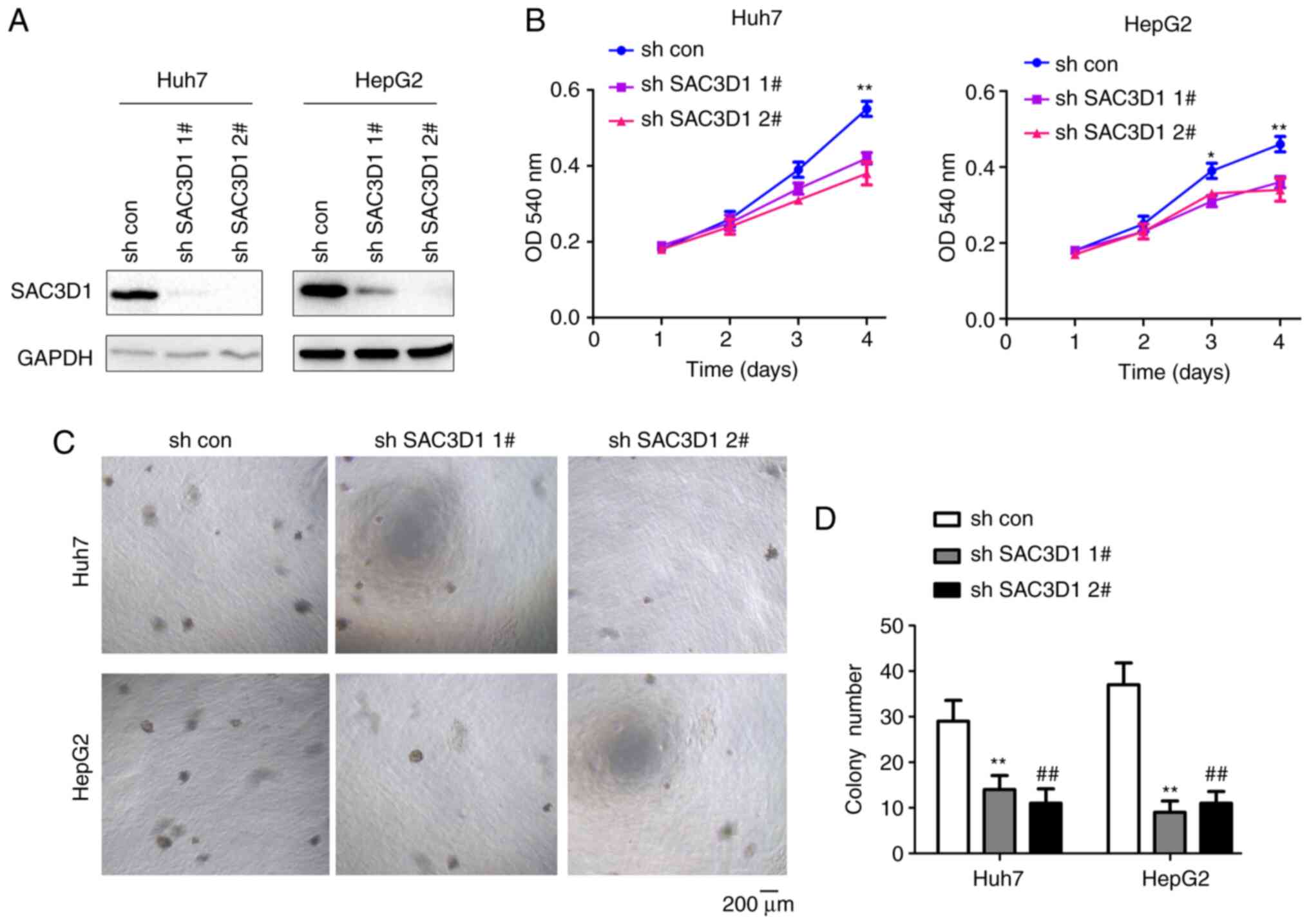|
1
|
Llovet JM, Kelley RK, Villanueva A, Singal
AG, Pikarsky E, Roayaie S, Lencioni R, Koike K, Zucman-Rossi J and
Finn RS: Hepatocellular carcinoma. Nat Rev Dis Primers. 7:62021.
View Article : Google Scholar : PubMed/NCBI
|
|
2
|
Altomonte J. Liver cancer, . Sensitizing
hepatocellular carcinoma to oncolytic virus therapy. Nat Rev
Gastroenterol Hepatol. 15:8–10. 2018. View Article : Google Scholar : PubMed/NCBI
|
|
3
|
Bruix J, da Fonseca LG and Reig M:
Insights into the success and failure of systemic therapy for
hepatocellular carcinoma. Nat Rev Gastroenterol Hepatol.
16:617–630. 2019. View Article : Google Scholar : PubMed/NCBI
|
|
4
|
Schunk SJ, Floege J, Fliser D and Speer T:
WNT-β-catenin signalling-a versatile player in kidney injury and
repair. Nat Rev Nephrol. 17:172–184. 2021. View Article : Google Scholar : PubMed/NCBI
|
|
5
|
Moon RT, Kohn AD, De Ferrari GV and Kaykas
A: WNT and β-catenin signalling: Diseases and therapies. Nat Rev
Genet. 5:691–701. 2004. View
Article : Google Scholar : PubMed/NCBI
|
|
6
|
Kypta RM and Waxman J: Wnt/β-catenin
signalling in prostate cancer. Nat Rev Urol. 9:418–428. 2012.
View Article : Google Scholar : PubMed/NCBI
|
|
7
|
Leavy O. Mucosal immunology, . β-catenin
calms the gut. Nat Rev Immunol. 10:6822010. View Article : Google Scholar : PubMed/NCBI
|
|
8
|
Mosimann C, Hausmann G and Basler K:
Beta-catenin hits chromatin: Regulation of Wnt target gene
activation. Nat Rev Mol Cell Biol. 10:276–286. 2009. View Article : Google Scholar : PubMed/NCBI
|
|
9
|
Clevers H. Axin and hepatocellular
carcinomas. Nat Genet. 24:206–208. 2000. View Article : Google Scholar : PubMed/NCBI
|
|
10
|
Ishizaki Y, Ikeda S, Fujimori M, Shimizu
Y, Kurihara T, Itamoto T, Kikuchi A, Okajima M and Asahara T:
Immunohistochemical analysis and mutational analyses of
beta-catenin, Axin family and APC genes in hepatocellular
carcinomas. Int J Oncol. 24:1077–1083. 2004.PubMed/NCBI
|
|
11
|
Tian W, Li J, Wang Z, Zhang T, Han Y, Liu
Y, Chu W, Liu Y and Yang B: HYD-PEP06 suppresses hepatocellular
carcinoma metastasis, epithelial-mesenchymal transition and cancer
stem cell-like properties by inhibiting PI3K/AKT and WNT/β-catenin
signaling activation. Acta Pharm Sin B. 11:1592–1606. 2021.
View Article : Google Scholar : PubMed/NCBI
|
|
12
|
Huang Y, Sheng H, Xiao Y, Hu W, Zhang Z,
Chen Y, Zhu Z, Wu D, Cao C and Sun J: Wnt/β-catenin inhibitor
ICG-001 enhances the antitumor efficacy of radiotherapy by
increasing radiation-induced DNA damage and improving tumor immune
microenvironment in hepatocellular carcinoma. Radiother Oncol.
162:34–44. 2021. View Article : Google Scholar : PubMed/NCBI
|
|
13
|
Yu Y, Zhang L and Xu J: LncRNA BANCR
promotes proliferation of hepatocellular carcinoma Huh-7 cells by
activating Wnt/beta-catenin signaling pathway. Minerva
Gastroenterol (Torino). Jun 11–2021.(Epub ahead of print).
View Article : Google Scholar
|
|
14
|
Yang T, Xu R, Huo J, Wang B, Du X, Dai B,
Zhu M, Zhan Y, Zhang D and Zhang Y: WWOX activation by toosendanin
suppresses hepatocellular carcinoma metastasis through JAK2/Stat3
and Wnt/β-catenin signaling. Cancer Lett. 513:50–62. 2021.
View Article : Google Scholar : PubMed/NCBI
|
|
15
|
Adebayo Michael AO, Ko S, Tao J, Moghe A,
Yang H, Xu M, Russell JO, Pradhan-Sundd T, Liu S, Singh S, et al:
Inhibiting glutamine-dependent mTORC1 activation ameliorates liver
cancers driven by β-catenin mutations. Cell Metab. 29:1135–1150.e6.
2019. View Article : Google Scholar : PubMed/NCBI
|
|
16
|
Han ME, Kim JY, Kim GH, Park SY, Kim YH
and Oh SO: SAC3D1: A novel prognostic marker in hepatocellular
carcinoma. Sci Rep. 8:156082018. View Article : Google Scholar : PubMed/NCBI
|
|
17
|
Liu AG, Zhong JC, Chen G, He RQ, He YQ, Ma
J, Yang LH, Wu XJ, Huang JT, Li JJ, et al: Upregulated expression
of SAC3D1 is associated with progression in gastric cancer. Int J
Oncol. 57:122–138. 2020.PubMed/NCBI
|
|
18
|
Nakajima H, Tamura T, Ito M, Shibata F,
Kuroda K, Fukuchi Y, Watanabe N, Kitamura T, Ikeda Y and Handa M:
SHD1 is a novel cytokine-inducible, negative feedback regulator of
STAT5-dependent transcription. Blood. 113:1027–1036. 2009.
View Article : Google Scholar : PubMed/NCBI
|
|
19
|
Livak KJ and Schmittgen TD: Analysis of
relative gene expression data using real-time quantitative PCR and
the 2(−Delta Delta C(T)) method. Methods. 25:402–408. 2001.
View Article : Google Scholar : PubMed/NCBI
|
|
20
|
Guan CN, Chen XM, Lou HQ, Liao XH, Chen BY
and Zhang PW: Clinical significance of axin and β-catenin protein
expression in primary hepatocellular carcinomas. Asian Pac J Cancer
Prev. 13:677–681. 2012. View Article : Google Scholar : PubMed/NCBI
|
|
21
|
Park JY, Park WS, Nam SW, Kim SY, Lee SH,
Yoo NJ, Lee JY and Park CK: Mutations of beta-catenin and AXIN I
genes are a late event in human hepatocellular carcinogenesis.
Liver Int. 25:70–76. 2005. View Article : Google Scholar : PubMed/NCBI
|
|
22
|
Kitao A, Matsui O, Yoneda N, Kozaka K,
Kobayashi S, Sanada J, Koda W, Minami T, Inoue D, Yoshida K, et al:
Hepatocellular carcinoma with β-catenin mutation: Imaging and
pathologic characteristics. Radiology. 275:708–717. 2015.
View Article : Google Scholar : PubMed/NCBI
|
|
23
|
Yu J, Xie Y, Li M, Zhou F, Zhong Z, Liu Y,
Wang F and Qi J: Association between SFRP promoter hypermethylation
and different types of cancer: A systematic review and
meta-analysis. Oncol Lett. 18:3481–3492. 2019.PubMed/NCBI
|
|
24
|
Xu C, Zeng XH, Wang L, Tao SQ, Wu QX, Zhu
P, Deng GH and Wang YM: sFRP-4, a potential novel serum marker for
chronic hepatitis B-related hepatocellular carcinoma. Hepatobiliary
Pancreat Dis Int. 14:164–170. 2015. View Article : Google Scholar : PubMed/NCBI
|
|
25
|
Bengochea A, de Souza MM, Lefrançois L, Le
Roux E, Galy O, Chemin I, Kim M, Wands JR, Trepo C, Hainaut P, et
al: Common dysregulation of Wnt/Frizzled receptor elements in human
hepatocellular carcinoma. Br J Cancer. 99:143–150. 2008. View Article : Google Scholar : PubMed/NCBI
|















